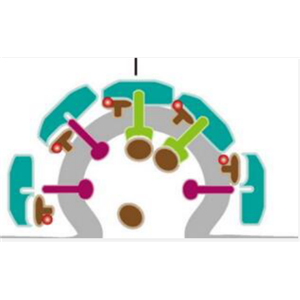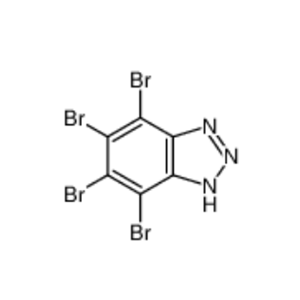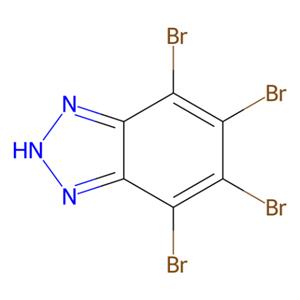| 名称 | TBB |
| 描述 | TBB (NSC-231634)(NSC-231634) is a highly selective, ATP/GTP-competitive inhibitor of casein kinase-2 (CK2). |
| 细胞实验 | TBB is dissolved in DMSO and stored, and then diluted with appropriate media before use[2]. PC-3 or HeLa cells are cultured routinely in RPMI-1640 and DMEM media, respectively, which are supplemented with 10% FBS, Penicillin (100 U/mL) and Streptomycin (100 μg/mL) at 37°C in a humidified atmosphere of 5% CO2. Cells are seeded at 5×104 cells/well (PC-3) or 2×104 (HeLa) in 24-wells plates and cultured for 72 h. TBB (final concentration 60 μM), CPT (final concentration 5.8 nM), 2-deoxyglucose (2-DG; final concentration 0.5 mM) or TRAIL (final concentration 13.3 ng/mL) are added to the medium individually or in a combination and the cells are cultured for additional time, indicated on each figure. After treatment, the medium with the agent is removed and 500 μL of MTT mixture (0.5 mg/mL for PC-3 and 5.0 mg/mL for HeLa cells in medium without phenol red) is added to each well and incubated for an additional 1 h at 37°C. The formazan crystals are diluted in 250 μL of DMSO. The absorbance is measured at 570 nm[2]. |
| 激酶实验 | Kinase assay: Total kinase activity of CaMKII, determined in a standard 2 min assay (100 μL), contained 35 mM HEPES, 10 mM MgCl2, 1 mM CaCl2, 10 μg of chicken gizzard myosin 20-kD light chain, 0.1 μM calmodulin, and 10 μM [γ-33]ATP at 30 °C. The kinase reaction is halted by adding 1 mL of 10% trichloroacetic acid. |
| 体外活性 | Investigation of the inhibitory power of TBB with a panel of 33 protein kinases shows highest potency for CK2 (casein kinase 2) (human CK2: IC50=1.6 μM at 100 μM ATP). TBB also inhibits three other kinases with less potency: CDK2 (IC50=15.6 μM), phosphorylase kinase (IC50=8.7 μM) and glycogen synthase kinase 3β (GSK3β) (IC50=11.2 μM). All other kinases tested have IC50 values 50-fold greater than that for CK2[1]. The viability of the androgen insensitive PC-3 cells may be diminished by TBB (60 μM TBB) acting either alone or combined with anticancer agents CPT or TRAIL when a proper time schedule of the administration is applied. However, the time schedule-dependent activity of TBB does not come from its effect on apoptosis in PC-3 cells[2]. It is because that TBB is an ATP/GTP competitive inhibitor of protein kinase casein kinase-2 (CK2) which has been examined against a panel of 33 protein kinases, either Ser/Thr- or Tyr-specific. In the presence of 10 μM TBB (and 100 μM ATP) only CK2 is drastically inhibited (>85%) whereas three kinases (phosphorylase kinase, glycogen synthase kinase 3L and cyclin-dependent kinase 2/cyclin A) underwent moderate inhibition, with IC50 values one-two orders of magnitude higher than CK2 (IC50=0.9 μM). TBB also inhibits endogenous CK2 in cultured Jurkat cells[3]. |
| 体内活性 | The extent of retinal neovascularization in a mouse OIR model is reduced by approximately 60% after treatment with TBB (6 days at 60 mg/kg per day) which is the most specific CK2 inhibitor known[4]. |
| 存储条件 | Powder: -20°C for 3 years | In solvent: -80°C for 1 year | Shipping with blue ice/Shipping at ambient temperature. |
| 溶解度 | DMSO : 43.5 mg/mL (100.07 mM), Sonication is recommended.
10% DMSO+40% PEG300+5% Tween 80+45% Saline : 2 mg/mL (4.6 mM), Sonication is recommended.
Ethanol : 100 mM, Sonication is recommended.
|
| 关键字 | TBB | NSC-231634 | NSC231634 | Inhibitor | inhibit | GSK-3β | GSK3 | CK2 | CDK2 | CaseinKinase | Casein Kinase |
| 相关产品 | Cromolyn sodium | 2-Chloropyrazine | Sodium Oxamate | Casein | 4-Chloro-2'-bromoacetophenone | Abemaciclib | Amantadine | Ellagic acid | Palbociclib | Dinaciclib | Kojic acid | Ethyl linoleate |
| 相关库 | 抑制剂库 | 神经保护化合物库 | 经典已知活性库 | 已知活性化合物库 | 激酶抑制剂库 | 高选择性抑制剂库 | 抗衰老化合物库 | HIF-1化合物库 | 膜蛋白靶向化合物库 | 免疫/炎症分子化合物库 | 神经退行性疾病化合物库 | 糖酵解化合物库 |





